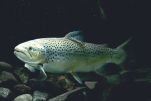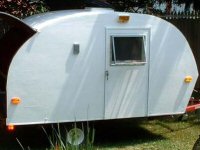As I continue to digest all things Foamy, I'm interested in some feedback from those of you with more experience on making a table with Foamy techniques.
My family has recently joined a group that has several teams competing in the FIRST Lego League, http://firstlegoleague.org/ which uses a 4'x8' competition table area. All the current tables we have are made from a sheet of 1/2" plywood with 2x4 edges. These are difficult to transport, and usually requires help getting it set up. Surfing the web I find that some teams make tables out of a sheet of foam with a single, centered duct tape hinge, and simply dispose of them once they get too beat up.
I think that a table could be made in 3 parts and assemble fairly quickly using a tongue and groove type joint. I know that GPW is convinced that TBII, canvas and paint are all that is needed for a skin on trailers, but I'm wondering if students banging around with Lego bricks, repeated tear down and set up, and hard points for fasteners requires a stronger skin. I managed to purchase several sheets of 1/4" red oak plywood on sale for $8 (thrifty!) each for use on the playing surface, I'm pretty sure that this is necessary to mimic the regulation playing surface. I wonder if the bottom surface can be skinned more economically with canvas.
This method could also be used to make very portable tables for camping that could be put inside trailers and easily pulled out for setup. The three main sections nest into each other and contain the 4 side rails in such a way that the whole package is about 48x34x6 inches.
Attached should be some pics from my AutoCAD drawings.
This one shows the 3 sections, 2 with the top skin removed to show the detail inside, I have not bothered to draw the foam in. As designed, if you need a smaller area table for other use, the 2 end pieces may be joined, leaving the center piece out. The side rails are in 2 sections each and are sized so that one will complete the rail in the smaller configuration. These rails are also designed to span the table joints to help stabilize them, rather than rely on the tongue and groove for all of the support.
This shows the detail of how the sections join together. My intent is to use a clear SPF 2x4 (I actually found some!) joint it square, surface it and machine what I want, including matching the thickness of a sheet of 1x foam.
Foam Tables?
Moderator: eaglesdare
24 posts
• Page 1 of 2 • 1, 2
Re: Foam Tables?
No reason why that would not work. Might I suggest you indent the tongue & groove width to eliminate a sharp corner since it is not needed anyway. We use the same technique to join roof panels and it works fine. I joined and removed my roof panels with the spline a number of times without issues so it will last a while.
I used a soldering iron with a piece of steel welding wire to hotwire out the panel edge - does not have to be too exact to work. Probably best to glue the spline in on one side for permanency.

I used a soldering iron with a piece of steel welding wire to hotwire out the panel edge - does not have to be too exact to work. Probably best to glue the spline in on one side for permanency.
my build thread viewtopic.php?f=55&t=63228
-

Fred Trout - The 300 Club
- Posts: 396
- Joined: Fri May 08, 2015 4:30 pm
- Location: SW Montana

 If you need something more durable , try some thin chipboard or poster board glued over the foam on the Use side and edges , then a light fabric ... should be pretty TOUGH...
If you need something more durable , try some thin chipboard or poster board glued over the foam on the Use side and edges , then a light fabric ... should be pretty TOUGH... 
 I Quit !!!
I Quit !!! 













